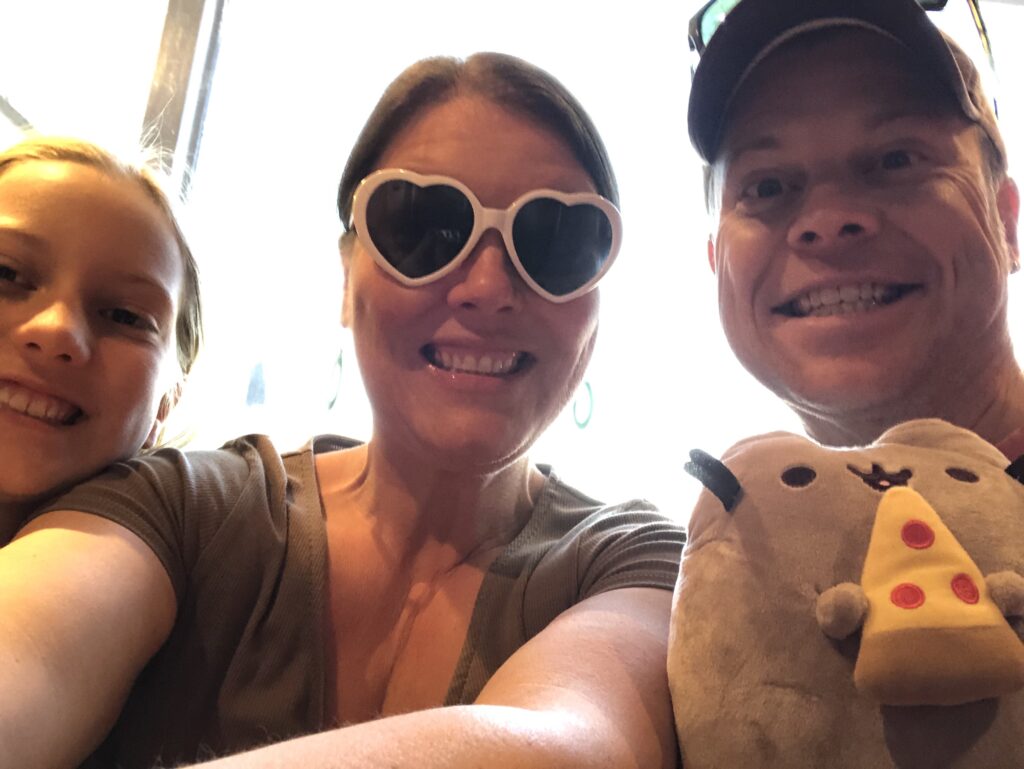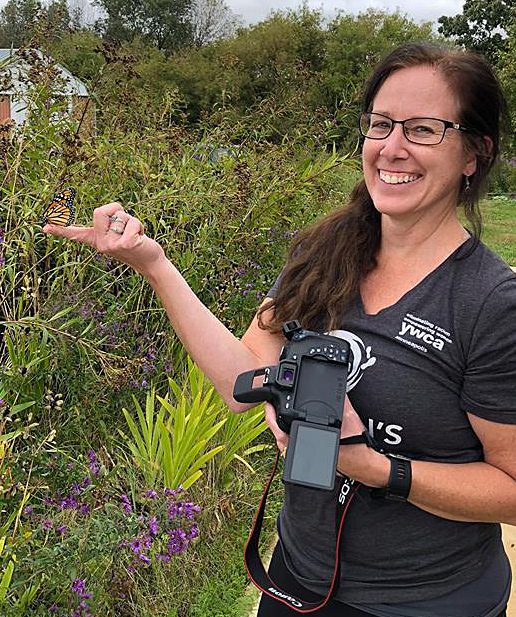
Eighteen years. It had been 18 years since I traveled off this continent, and got fresh perspectives and new inspiration from seeing the world. But in April 2023, we reset that ticker with a trip to Greece. International travel was achieved once again, and this time, my whole family was along!

International Family Travel
When I graduated from University of Iowa in 2003, I knew I wanted to Travel. That “t” is capitalized for a reason – I wanted to live on another continent, and really get to know some places other than the ones I’d known since birth.
I looked into being an au pair or joining the Peace Corps, I applied for a fellowship in Germany, and also for a job teaching English in China. I got the teaching gig, and prepared myself to not only leave the continent for the first time in my life, but go halfway across the world to do it.
It was one of the best decisions of my life. It not only informed my work with Inspire(d) – because if people are good on our side of the world AND the other side of the world, logic implies there’s a whole lot of good folks in between as well – but it also added an even greater sense of wonder to my already pretty massive sense of wonder at the world. (Read one of my memories of that time here.) There are some seriously beautiful things in nature and to be learned through history, and the fact that we get to witness them is truly a marvel!
When we had our daughter, Roxie, I knew I wanted to try to share experiences like that with her as well. What we had to figure out was timing and money.




Timing
Kudos to families that travel with small children. We are not one of those families (at least not to more logistic-heavy locations like Greece). We decided to wait until Roxie was old enough to remember the destinations, strong enough to lug her own suitcase (for the most part), and responsible enough to pack her own clothes. At the time of our trip, Roxie was 10 (and three-quarters), and we felt like she was ready to tackle this trip. (Spoiler: She did great! But she was still a 10-year-old, and didn’t have the stamina of an adult.)
The other timing part of it was our dog. We have a bernedoodle named Athena, and we are her guardian family. That means we have taken care of her from puppyhood on, socializing her and in general making her part of our family, and that when it’s time for her to have puppies, she goes to the home of the breeders – in this case Bluff Country Bernedoodles – where she has and then nurses her puppies. We agreed to a certain number of breedings, and once she’s done, Athena is our dog to keep forever, free of charge. It has been very interesting to learn more about dog’s gestation cycles and mama dog instincts and all of that (did you know it only takes nine weeks to gestate puppies?!).
While we were making this decision on being a guardian family in early April 2020, one of the things in the “pro” column was that there would be a handful of eight-week time periods where our dog would be on what we lovingly called “maternity leave.” We wanted to use these blocks of time as catalysts for traveling as a family. Because it’s so easy to let time slip by, with the “oh, we’ll do that someday,” mantra on repeat.
Athena’s first litter of puppies was due in mid-April 2023, so that some day was no longer a vague moment in the ether. It was time to plan!

Planning Our Trip
When dreaming about our first international trip as a family, we asked Roxie where she would want to go. She immediately said Greece! She and I were in the middle of reading the Rick Riordan Percy Jackson series (and all the other related series to follow), and were learning a lot about Greek gods and goddesses. I love the idea of travel connected to books (watch for a future post about that), Greece seemed like one of those “trip of a lifetime” places, and I was ready for some culture that felt vastly different from American culture (akin to my time in China).
Plus, the fact that our dog’s name is Athena seemed like the universe pointing us across the Atlantic to the Mediterranean.
We got to work figuring out a (what we like to call) “Frugal High Life” trip that would involve saving money where we could, and spending it when it was important. It equaled a travel experience that worked great for us, and we’re excited to share more about it.
We traveled from April 10 to April 28, 2023.
Our itinerary was as follows:

April 10-12: Ames
Odd place to start a voyage to Greece, I know, but we went to the Iowa Rural Summit! I spoke at a Round Table, and then Benji and I were among the winners of the 2023 Rand Fisher Rural Leadership Award!

April 12: Chicago O’Hare to fly SAS
Flying from Chicago O’Hare meant our flight was a lot cheaper than if we went from MSP (even though the drive is 4.5 hours from Decorah, and even a little farther from Ames). I started with a google flights search to see where prices were landing during our travel window, and that was consistently the case. Plus the flight times were better. (FYI, we booked everything late February to travel in April.) We flew overnight, leaving at 10 pm, and arriving in Copenhagen in the afternoon on April 13. SAS (Scandinavian Airlines System) gets really good marks in my book (even though Roxie dreaded the nine-hour flight home after experiencing her first long haul flight on the way there).

April 13-15: Copenhagen
The SAS flights routed us through Copenhagen on both ends of our trip, and at both times it was an overnight layover. We decided to extend our layover on the front end of our trip, so we could actually check out Copenhagen (really quickly). We were able to do this by booking our flights through Expedia. Watch for our “48 Hours in Copenhagen” post to come! We LOVED this city! We stayed in the cutest hotel! And don’t get me started on the amazing Scandinavian breakfast spreads! I loved it all so much.

April 15-19: Athens
Our flight into Athens arrived on the eve of Orthodox Easter (around 8:30 pm). We took the metro downtown from the airport, and came out of the station right into view of the Parthenon! There was a lot of Orthodox Easter excitement! In our four days in Athens, we explored on foot, did a Parthenon tour, took a bus to Delphi / Arachova for a great day trip (both through Get Your Guide – loved this website for booking tours), and did lots of laundry in our Airbnb (it was in a fabulous location for sightseeing), ha!

April 19-22: Santorini
We took the shortest flight I’ve ever had from Athens to Santorini (and it was cheaper than the at-least five-hour ferry ride). In Santorini, we had a wonderful hotel (Altemar Suites) with our own personal balcony and our own personal hot tub! Santorini gives you those blue-roof-views you often imagine when you’re thinking of Greece (Greece islands, especially). We did a cool day trip tour that took us by boat to the active volcano, hiked to the top and back down, then boated to an area where we jumped into the Aegean Sea and swam over to volcanic hot springs! It was pretty epic, as were the Santorini sunsets.

April 22-25: Naxos
We left Santorini on a 2.5 hour slow Blue Star Ferry to Naxos, and loved that mode of transport for that amount of time (and longer would have been fun too, honestly). Naxos was the “chill beach vacation” part of our trip, although it was a little cool for actual beach chilling. We loved the labyrinthine streets of Old Naxos and exploring the little stores that seemingly appeared like magic around every corner. Plus, we had an adorable Airbnb with super cool Cycladic architecture.

April 25-26: Athens / Artemida-Artemis
Rounding the wagons back toward home, we flew from the tiny Naxos airport to Athens, and stayed at a beach Airbnb in a small town near the airport (Artemida-Artemis). It was fun to see another part of the Athens area, and get one more day to dip our toes in salt water.

April 26-27: Copenhagen, with an overnight in Malmo, Sweden
The flight the next day took us from Athens back to Copenhagen. But instead of heading back into this lovely Denmark city, we decided to take the 20-minute train ride (which goes under the channel!) to Malmo, Sweden! Woot, one more country added to the list! We didn’t extend this layover, so it was just one night in Sweden (in a fancy hotel we booked with points!).

April 27: Chicago
Our flight was delayed, but I honestly love a good airport beer so I was okay with the extra time. This flight left in the early evening, so we chased the sunset the whole way home! Upon landing in Chicago, we waited in line for an hour at U.S. customs in a sad, windowless part of O’Hare. But we made it through, got our bags, and took a shuttle to where our Dodge Grand Caravan was waiting in a Park and Fly (booked through way.com).

April 28: Home to Decorah by 2 am.
We thought about staying in a hotel on the way home, but we were all ready to be in our own beds again, and I didn’t want to pack the suitcase one more time! So I chugged some gas station coffee and powered through it.
In the coming weeks, we’ll share different details about our trip! I love planning and putting puzzle pieces together (it’s a lot like making a magazine), and had a great time researching guided tours, ways to connect the Rick Riordan books, and how best to find that balance between travel hustle and vacation chill. Here’s what we’re hoping to cover:
• Travel Connected to Books
• Pros / Cons of Flying Overnight
• Extended Layovers
• 48 Hours in Copenhagen
The Nichols Family in Greece!
The three legs of our Greece itinerary in more detail, including tour reviews and favorite spots!
• Athens
• Thira, Santorini
• Old Naxos Town, Naxos
And (maybe) more (like Airbnbs vs Hotels, exchanging money in Greece…)!
Planning your own trip? Use this International Family Travel Checklist (I love a good list!) to get ready to go!

Speaking of lists, here’s a little playlist I put together that brought back the Greece vibes for me. There are some retro songs on this list that we heard in random shops or in cars going down the streets, so I had to add them!















